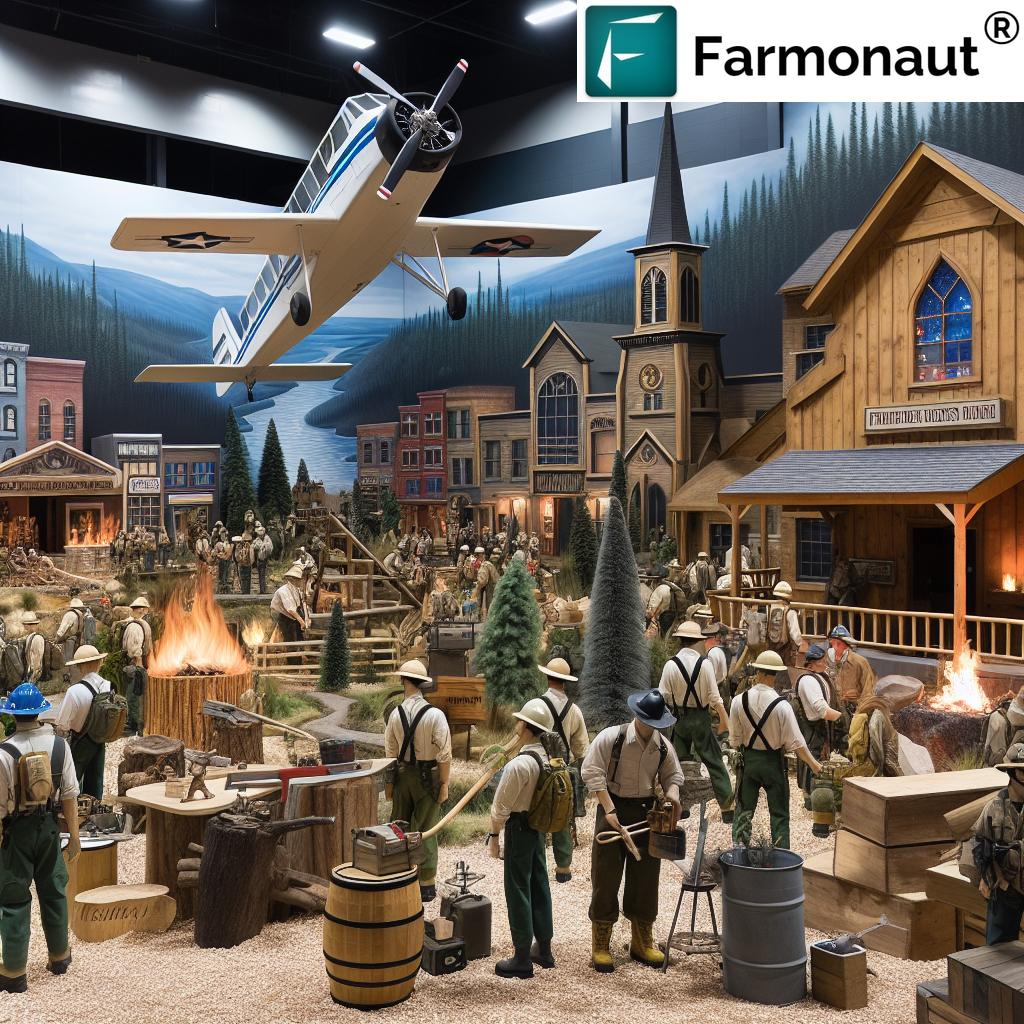Preserving Montana’s Forests: How Farmonaut Supports Wildfire Management and Conservation Efforts
“The University of Montana’s Foresters’ Ball, now in its 106th year, transforms Schreiber Gym into a logging town with multiple attractions.”
Welcome to the heart of Montana’s forestry conservation efforts! As we delve into the rich history and ongoing initiatives to protect our cherished forests, we’ll explore how modern technology, including Farmonaut’s innovative solutions, is revolutionizing wildfire management and conservation practices in the Treasure State.

The Legacy of Montana’s Forestry Conservation
Montana’s commitment to forestry conservation and wildfire management has a storied past, deeply rooted in the state’s culture and economy. From the establishment of the first national forests to the pioneering of modern firefighting techniques, Montana has been at the forefront of forest protection and sustainable resource management.
Let’s take a journey through time to understand the milestones that have shaped Montana’s approach to forestry conservation:
| Year | Event | Significance |
|---|---|---|
| 1913 | First Foresters’ Ball | Initiated tradition of celebrating forestry |
| 1940 | Smokejumper program established | Revolutionized wildfire response |
| 1988 | Yellowstone fires | Largest wildfire in Montana’s recorded history |
| 2023 | 106th Foresters’ Ball | Honoring wildfire suppression tactics |
This rich history sets the stage for the ongoing efforts to preserve Montana’s forests, which brings us to the present day and the innovative technologies supporting these endeavors.
The Role of Technology in Modern Forestry Conservation
In recent years, the integration of advanced technologies has dramatically enhanced our ability to monitor, manage, and protect Montana’s forests. Satellite imagery, artificial intelligence, and data analytics have become indispensable tools in the fight against wildfires and the pursuit of sustainable forest management.
One such technological advancement comes from Farmonaut, a pioneering agricultural technology company that offers satellite-based farm management solutions. While primarily focused on agriculture, Farmonaut’s technologies have found valuable applications in forestry and wildfire management.
Farmonaut’s platform provides real-time monitoring capabilities that can be adapted for forest health assessment, early fire detection, and post-fire recovery tracking. By leveraging multispectral satellite imagery, Farmonaut’s technology can help forestry officials identify areas of stress or potential fire risk within vast forest expanses.
Farmonaut’s Contribution to Wildfire Management
While Farmonaut’s primary focus is on agricultural applications, its technology has potential benefits for wildfire management and forest conservation efforts. Here’s how Farmonaut’s solutions could be adapted to support these critical areas:
- Satellite-Based Monitoring: Farmonaut’s use of multispectral satellite imagery could be applied to monitor large forest areas for signs of stress or potential fire hazards.
- AI-Driven Insights: The Jeevn AI Advisory System could be adapted to provide real-time insights on forest health and potential fire risks.
- Resource Management: Farmonaut’s tools for fleet and resource management could assist in optimizing the deployment of firefighting resources during wildfire events.
- Carbon Footprint Tracking: This feature could help in assessing the environmental impact of wildfires and guide reforestation efforts.
It’s important to note that while these applications are potential uses of Farmonaut’s technology, the company’s current focus remains on agricultural applications. However, the principles behind their solutions demonstrate the broader potential of such technologies in environmental management and conservation efforts.
The University of Montana’s 106th Foresters’ Ball: A Celebration of Conservation
As we consider the technological advancements in forestry, it’s crucial to remember the human element and the rich traditions that have shaped Montana’s approach to forest conservation. The University of Montana’s 106th Foresters’ Ball is a prime example of how the state honors its forestry heritage while looking towards the future.
“Montana’s forestry event honors fallen smokejumpers and features a replica of the Miss Montana firefighting plane, showcasing wildfire management history.”
This year’s theme, “Tankers Dumpin’ & Crews a Jumpin’,” pays homage to the brave firefighting crews across Montana. The event transforms Schreiber Gym into a vibrant logging town, complete with a saloon, chapel, and live western music. It’s not just a celebration but an educational experience that highlights Montana’s conservation efforts and wildfire management history.
Honoring the Past, Preparing for the Future
The Foresters’ Ball serves as a bridge between Montana’s rich forestry history and its future in conservation. Key features of this year’s event include:
- A replica of the Miss Montana firefighting plane
- A tribute to fallen smokejumpers, particularly those lost in the 1949 Mann Gulch Fire
- Educational displays on modern forestry practices and wildfire suppression tactics
- Demonstrations of the latest in forestry technology and conservation techniques
These elements not only honor the sacrifices made by firefighters but also educate attendees on the evolution of wildfire management and the importance of ongoing conservation efforts.
The Role of Education in Forest Conservation
The University of Montana’s W.A. Franke College of Forestry and Conservation plays a crucial role in shaping the future of forest management and conservation in the state. The Foresters’ Ball is just one aspect of their comprehensive approach to forestry education. Their programs focus on:
- Sustainable forest management practices
- Advanced wildfire suppression tactics
- Ecological restoration techniques
- Integration of technology in forestry and conservation
By preparing the next generation of forest managers and conservationists, the university ensures that Montana’s forests will be in capable hands for years to come.
Farmonaut’s Potential Impact on Forestry Education
While Farmonaut’s primary focus is on agricultural applications, its technology could potentially be adapted to support forestry education programs. Here’s how Farmonaut’s solutions might contribute to forestry education:
- Practical Training: Students could use Farmonaut’s satellite imagery analysis tools to study forest health and learn about remote sensing techniques in forestry.
- Data Analysis Skills: The platform’s data interpretation features could help students develop critical analytical skills needed in modern forestry management.
- Sustainable Practices: Farmonaut’s emphasis on sustainable resource management aligns with the principles taught in forestry conservation programs.
It’s important to note that while these are potential educational applications, Farmonaut’s current focus remains on agricultural technology. However, the principles behind their solutions demonstrate the broader potential of such technologies in environmental education and research.
The Future of Forestry Conservation in Montana
As we look to the future, Montana’s commitment to forestry conservation and wildfire management continues to grow stronger. The recently launched “Treasure Montana: Cultivating Our Tomorrow” fundraising campaign is a testament to this commitment. This initiative aims to raise $20 million in private funding for a new, state-of-the-art 60,000-square foot center dedicated to environmental and conservation research.
This new research center will likely incorporate cutting-edge technologies similar to those used by companies like Farmonaut, adapting them for forestry applications. The integration of such technologies with traditional forestry practices promises to revolutionize how we approach forest conservation and wildfire management.
Community Involvement in Forest Conservation
The success of Montana’s forestry conservation efforts relies heavily on community involvement. Events like the Foresters’ Ball and Community Forestry Day play a crucial role in educating the public and fostering a sense of stewardship for the state’s forests. Here are some ways the community can get involved:
- Participating in local conservation events and workshops
- Supporting fundraising efforts for forestry research and education
- Volunteering for forest clean-up and restoration projects
- Staying informed about local forestry policies and initiatives
By engaging the community in these efforts, Montana ensures that its forests will be protected and cherished for generations to come.
The Role of Technology in Community Engagement
While Farmonaut’s focus is on agricultural technology, the principles behind their user-friendly apps and interfaces demonstrate how technology can be leveraged to engage communities in environmental efforts. Similar approaches could be adapted for forestry conservation:
- Mobile apps for reporting forest conditions or potential fire hazards
- Interactive platforms for educating the public about local forests and conservation efforts
- Crowdsourcing initiatives for data collection on forest health and biodiversity
These technological approaches could significantly enhance community involvement in forest conservation efforts.
Conclusion: A Sustainable Future for Montana’s Forests
As we’ve explored throughout this article, Montana’s approach to forestry conservation and wildfire management is a blend of honoring traditions, leveraging modern technology, and fostering community engagement. From the historic Foresters’ Ball to the cutting-edge research facilities on the horizon, Montana continues to lead the way in forest protection and sustainable management.
While companies like Farmonaut focus on agricultural applications, the principles behind their technologies demonstrate the potential for similar innovations in forestry. As we move forward, the integration of such technologies with traditional forestry practices will be crucial in addressing the challenges of climate change, increasing wildfire risks, and the need for sustainable resource management.
By continuing to invest in education, research, and community engagement, Montana ensures that its forests will remain a treasured resource for generations to come. The state’s commitment to balancing conservation with sustainable use sets an example for forest management practices worldwide.
FAQs
- What is the Foresters’ Ball?
The Foresters’ Ball is an annual event at the University of Montana that celebrates forestry conservation while honoring wildfire suppression tactics and firefighting crews. - How does technology contribute to forest conservation in Montana?
Technology, including satellite imagery and data analytics, helps in monitoring forest health, early fire detection, and optimizing resource management for wildfire suppression. - What is the “Treasure Montana: Cultivating Our Tomorrow” campaign?
It’s a fundraising initiative aimed at raising $20 million for a new environmental and conservation research center at the University of Montana. - How can the community get involved in forest conservation efforts?
Community members can participate in local events, support fundraising efforts, volunteer for restoration projects, and stay informed about forestry policies and initiatives. - What role does education play in Montana’s forestry conservation?
Education, particularly through programs at the University of Montana, is crucial in preparing future forest managers and conservationists, ensuring sustainable practices for years to come.
















